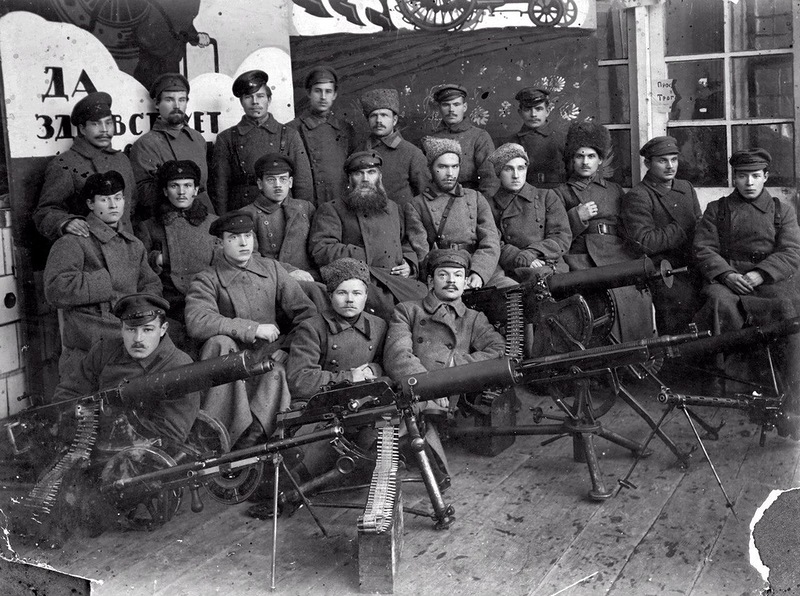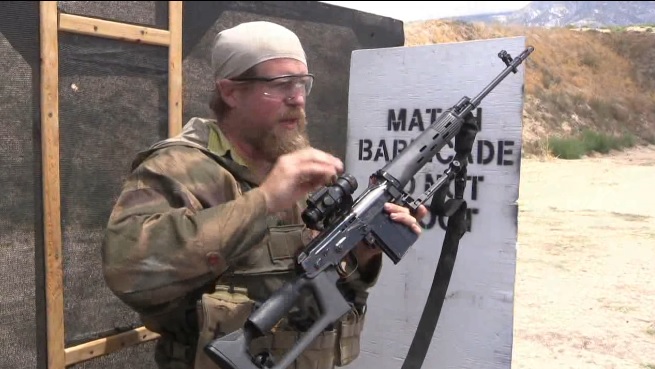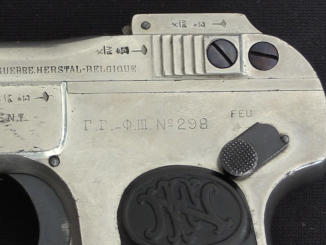
An assortment of machine guns from the Russian civil war. Pretty much one of everything in there – a Russian 1905 Maxim, German MG08, Austrian Schwarzlose 07/12, Colt 1895 “Potato Digger”, M1915 Chauchat, Madsen LMG, and a Lewis gun way in the back. Thanks to Paul Scarlata for sending the photo!




It’s a machine gun-fest! How do these guys get enough ammo for all of the guns? Whose side are they on, the Red team or the White team?
Ian, I love your Saturday morning photos! thank you
Could you fire 7.62×54 in a Schwarzlose?
MG school perhaps?
What was the purpose of the little shield behind the muzzle on the MG08? I’m not sure whether I’ve seen it on every picture I’ve seen of one, but it’s always puzzled me when I have. Is it some kind of shield to protect the cooling jacket from shell fragments?
It’s a blast deflector to prevent the rather impressive muzzle overpressure of the 7.9×57 round from actually “dishing” the front of the water jacket. If your mother ever canned vegetables in Ball (TM) jars, the effect of the overpressure is a lot like the “thunk” as the heated air in the jar cooled after you took it out of the pressure canner, and outside air pressure pushed the lid downward, making the airtight seal.
Imagine that kind of overpressure differential hitting the front of the water jacket about ten times every second, even during short bursts, and you can see why that disc of 5mm thick steel came in very handy.
As a bonus, at night it helped reduce the glare of muzzle flash (that the conical flash hider didn’t entirely contain) from the gunner’s POV, helping to preserve his night vision.
cheers
eon
Notice that Schwarzlose MG lacks the distinctive conical flash-hidder at the muzzle.
This one never had a flash-hidder since it is one of the original M 07 models. I wounder how it made its way to russia…..
Why did other Maxim types (including the forerunning MG01 in the same calibre) not then require the same device?
I understood it to be purely a means of minimising the flash visible to the enemy from the booster ports located *behind* the conical flash-hider (& therefore not hidden by it). That’s certainly what Mr Goldsmith’s book states.
“blast deflector to prevent the rather impressive muzzle overpressure of the 7.9×57 round from actually “dishing” the front of the water jacket”
What? I don’t know where that came from but I don’t think so. As Noted, no other MGs ever had it. I own a MG08. You could hit the front of the waterjacket with a hammer and not “dish” it. I don’t think so. Also note the MG08/15 did not have the disk either.
No its a flash shield for the booster. Also note that the Germans often used muzzle glands and there was no disk and the barrel was sticking out exposed.
Finally, not to be picky on Ian, but thats a 1905 Russian Maxim. Note the Roller feedblock and grips with no wood handles. Its also got the extremely early booster on it which was stopped around 1908.
Fixed – good catch!
Here’s what Col. George Chinn had to say in 1951;
Seen in this light, this photo pretty much sums up the situation on both sides of the civil war at that time.
cheers
eon
“Agents were sent to various friendly or neutral countries to buy weapons to bolster the sagging armies.”
One of them was Fyodorov (designer of Fyodorov Avtomat), he later wrote book “В поисках оружия” (Воениздат 1964).
“During the 2 years of civil war after Russia withdrew from the war against Germany, a Russian named Fedrov designed an automatic shoulder rifle of which only a few were used.”
The Fyodorov (or Fedorov not Fedrov) developed his automatic rifle before WW1. It was combat-tested in June-September of 1916 (50 examples).
“Desperate shortages of arms occurred in Russia soon after World War I began”
Situation was so desperate that Russia even bought obsolete and not cartridge-compatible Gras rifle.
“Could you fire 7.62×54 in a Schwarzlose?”
in a german or austrian schwarzlose ? no.
Probably with some effort. Czechs adopted A-H Schwarzlose to their military in early 1020s and altered caliber to common 7.92mm Mauser http://cs.wikipedia.org/wiki/T%C4%9B%C5%BEk%C3%BD_kulomet_vz._24
It was used at least for 10 years before replacement and was even exported.
But the 7.62x54R has smaller bullet diameter that 8x50R Mannlicher – .312 vs .321. Powder gases can escape around bullet so I suspect the poor accuracy and reliability (not enough power to cycle). So to make Schwarzlose working reliably with 7.62x54R new barrel would be needed.
An excellent history of the Russian Civil War is a book by W Bruce Lincoln: “Red Victory”…not an ‘easy’ read but very good if you have patience to read it…The Bolsheviks were very much like the ‘left’ of today (or vice versa)- ignorant (despite their vast amounts of ‘theory’ by which they expected to rule) and viciously brutal…Trotsky was perhaps the worst of the lot…
I’m sure there’s even a good history book for the likes of you. With lots of pictures.
Bear in mind that Lewis and Potato Digger were both manufactured in 7,62 Russian for Russia, and Russians also had 7.62x54R chambered Madsens – in fact, they bought a license to manufacture them, and built a factory in Kovrov, but because of the revolution didn’t managed to start manufacturing them. There, at the unfinished Kovrov factory, a small arms design bureau was established, headed by ex-Tsarist general, Fedorov, whose assistant was Degtyarov (known in the West as Degtarev). The early 7.62x54R case was in fact based on 8 mm Mannlicher, and Russians were even manufacturng Austrian ammunition to fire in captured guns: rebuilding Austrian gun to fire Russian ammo (before the 1920s-reformed case with more triangular neck was introduced) couldn’t be THAT hard, especially the delayed blowback gun.
Never seen anything about Russification of the German Maxims, but Germanification of Russian Maxims was a massive industry, and was mostly an almost modular thing, using German parts to replace Russian counterparts. Perhaps it was as simple the other way round – but I have never seen a photo of Russian gun crew with visually identifiable German Maxim.
So it seems that of all these MGs, only the poor little orphan CRDG (Chauchat) never had a 7,62x54R modification…
triangular SHOULDER of course, not neck. And the Russian Mannlichers were utilizing shortened 54R case with 8 mm bullet – these were made by the Petrograd Ammo Works.
Interesting; that explains beginning of Kovrov machine plant http://www.army-guide.com/eng/firm2832.html
From movies I have seen since school years I recall that gun of Red Army was Maxim. I particularly liked the whipping outer linkage; it was cute.